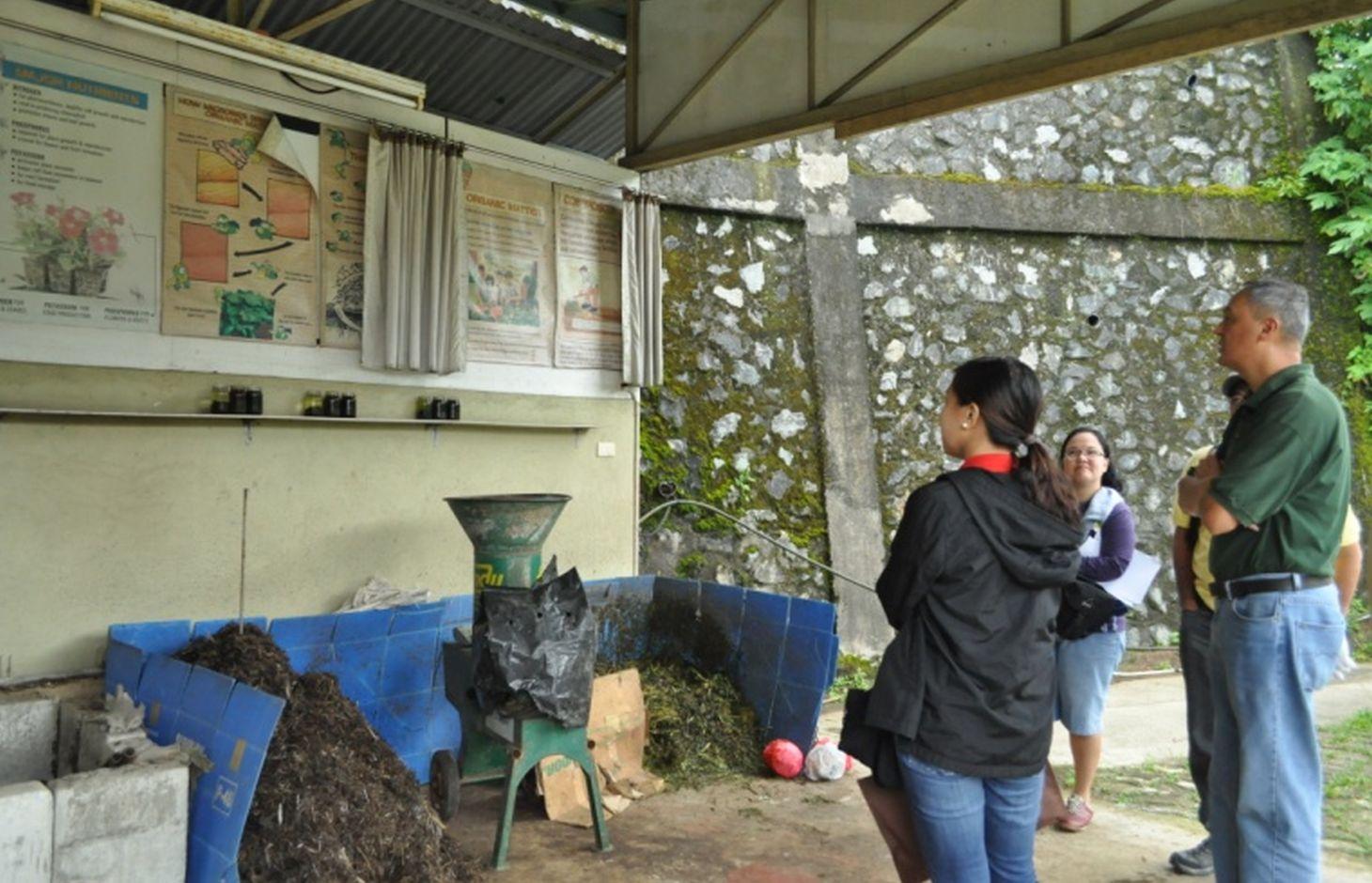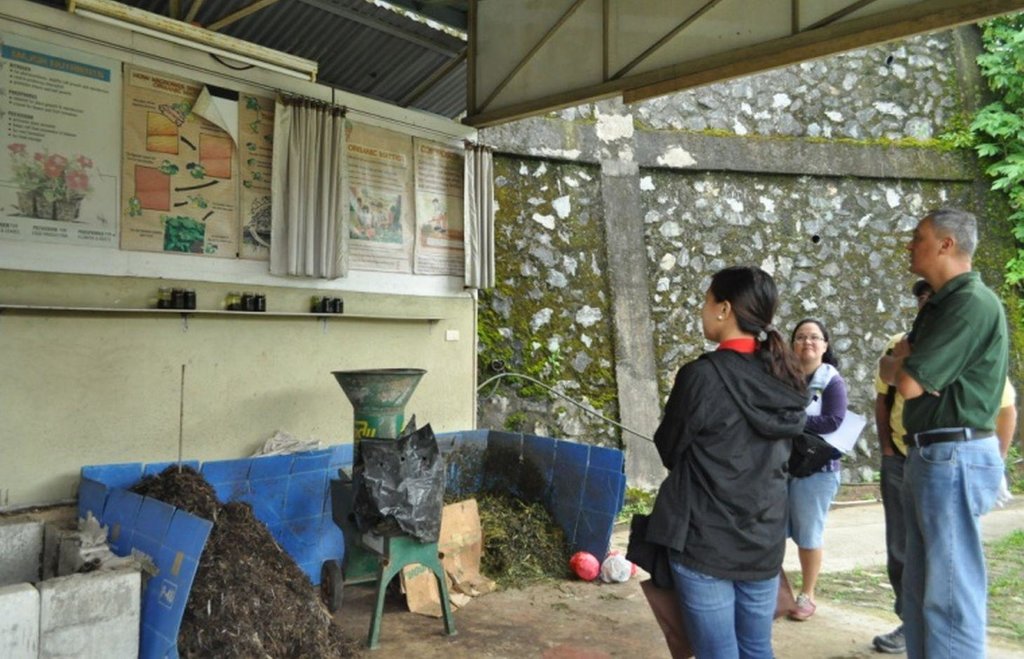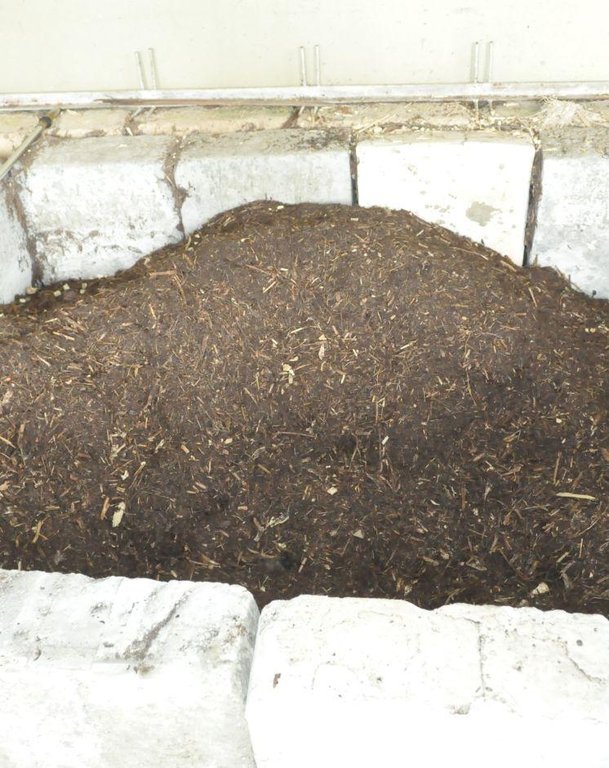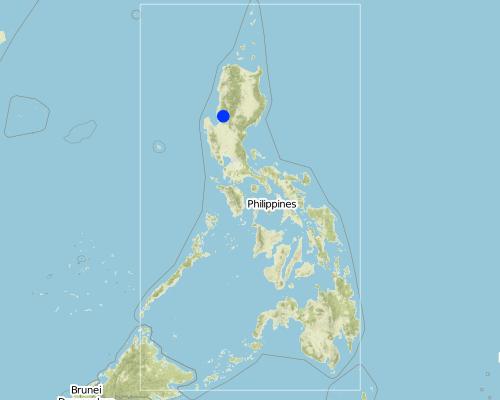Composting using Indigenous Microorganism (IMO) [Philippines]
- Creation:
- Update:
- Compiler: Philippine Overview of Conservation Approaches and Technologies
- Editor: –
- Reviewer: Fabian Ottiger
technologies_1317 - Philippines
View sections
Expand all Collapse all1. General information
1.2 Contact details of resource persons and institutions involved in the assessment and documentation of the Technology
Key resource person(s)
SLM specialist:
Penaranda Melijoy
Department of Agriculture-Bureau of Soils and Water Management
5th Floor, Department of Agriculture Building, Elliptical Road, Quezon City, 1100 Metro Manila, Philippines
Philippines
SLM specialist:
Bernardino Renel
Department of Agriculture-Bureau of Soils and Water Management
5th Floor, Department of Agriculture Building, Elliptical Road, Quezon City, 1100 Metro Manila, Philippines
Philippines
SLM specialist:
Magno Beatriz
Department of Agriculture-Bureau of Soils and Water Management
5th Floor, Department of Agriculture Building, Elliptical Road, Quezon City, 1100 Metro Manila, Philippines
Philippines
land user:
Ambrocio Acosta
09179258499
Master's Garden
Lamtang - Pico Road, Sitio Piinalayok, Pugis, La Trinidad, Benguet, Philippines
Philippines
Name of the institution(s) which facilitated the documentation/ evaluation of the Technology (if relevant)
Bureau of Soils and Water Management (Bureau of Soils and Water Management) - PhilippinesName of the institution(s) which facilitated the documentation/ evaluation of the Technology (if relevant)
The Master's Garden - Philippines1.3 Conditions regarding the use of data documented through WOCAT
When were the data compiled (in the field)?
15/09/2013
The compiler and key resource person(s) accept the conditions regarding the use of data documented through WOCAT:
Ja
2. Description of the SLM Technology
2.1 Short description of the Technology
Definition of the Technology:
Composting is the natural process of decomposition of organic matter by microorganisms under controlled conditions.
2.2 Detailed description of the Technology
Description:
Composting is the decomposition of grass and weeds as fertilizer with the aid of indigenous microorganisms (IMO). This technology is practiced to produce compost used in the farm. Compost is a rich source of organic matter which improves soil tilth. Its decomposition slowly release available nutrients for plant uptake.Material used in the production are weeds and bio waste available in the farm which include Agetarum houstonianum, Dentella repens, Setaria palmifolia, Ipomea aquatica, Echinochloa crusgali, Helianthus annuus and Digitaria ciliaris. The compost is applied in the organic vegetable production of the farm. Vegetables planted include lettuce, herbs, kale and others that are used for garden salads.
Purpose of the Technology: The purpose of composting is to produce compost that is utilized as fertilizer for the soil. It is done to reduce the input cost of using chemical fertilizer and to avoid lasting harms to the soils and the environment (e.g. formation of impermeable layer "hardpan", affection of micro-organisms, and upsetting of pH).
Establishment / maintenance activities and inputs: The initial step in making compost is gathering of raw materials such as weeds and grasses available in the farm. Then, these are shredded and sprayed with IMO to hasten the decomposition. IMO is produced by mixing one tablespoon of forest soil and one tablespoon of sugar/molasses in one liter of water. A portion of the mixture (250ml) is extracted and diluted in a 16 liter knapsack sprayer. The diluted mixture is sprayed to the shredded grasses/weeds and left to decompose for 14 days. For a 1 ton of shredded grass and weeds, 16L of diluted mixture is needed.
Natural / human environment: Master’s Garden of Mr. Ambrocio Acosta is located at Barangay Puguis, La Trinidad, Benguet. The province is under Type I climate by the Coronas system of classification with distinct wet and dry seasons with an average annual rainfall of 3,879 mm. The dry season is from November to April while the wet season is from May to October. The farm has an elevation of 1,342 meters above sea level with less than 40% slope. The farm was manually terraced and arranged into beds with UV treated plastic shed. The production system is managed and cultivated by Mr. Acosta and his two farm laborers.
2.3 Photos of the Technology
2.5 Country/ region/ locations where the Technology has been applied and which are covered by this assessment
Country:
Philippines
Region/ State/ Province:
La Trinidad, Benguet
Map
×2.6 Date of implementation
If precise year is not known, indicate approximate date:
- 10-50 years ago
2.7 Introduction of the Technology
Specify how the Technology was introduced:
- through land users' innovation
Comments (type of project, etc.):
Composting was practice since they started developed the farm on year 2000.
3. Classification of the SLM Technology
3.2 Current land use type(s) where the Technology is applied

Cropland
- Annual cropping
- Perennial (non-woody) cropping
Main crops (cash and food crops):
Major cash crop annual cropping: lettuce, tomatoes, cucumber, sugar beets, salad pe
Major cash crop perennial (non woody) cropping: Thyme, mint, tarragon and chives
Major food crop annual cropping: lettuce and tomato
Comments:
Major land use problems (compiler’s opinion): Since the farm has steep slope, soil erosion was prevalent resulting to low fertility of the soil
Major land use problems (land users’ perception): Soil erosion caused by rainfall leaving them nothing but an exposed subsoil layer.
Future (final) land use (after implementation of SLM Technology): Cropland: Ca: Annual cropping
If land use has changed due to the implementation of the Technology, indicate land use before implementation of the Technology:
Grazing land: Ge: Extensive grazing land
3.3 Further information about land use
Water supply for the land on which the Technology is applied:
- full irrigation
Number of growing seasons per year:
- 2
3.4 SLM group to which the Technology belongs
- integrated soil fertility management
3.5 Spread of the Technology
Specify the spread of the Technology:
- evenly spread over an area
If the Technology is evenly spread over an area, indicate approximate area covered:
- < 0.1 km2 (10 ha)
3.6 SLM measures comprising the Technology

agronomic measures
- A2: Organic matter/ soil fertility
Comments:
Main measures: agronomic measures
Type of agronomic measures: manure / compost / residues
3.7 Main types of land degradation addressed by the Technology

soil erosion by water
- Wt: loss of topsoil/ surface erosion

chemical soil deterioration
- Cn: fertility decline and reduced organic matter content (not caused by erosion)
Comments:
Main type of degradation addressed: Wt: loss of topsoil / surface erosion, Cn: fertility decline and reduced organic matter content
Main causes of degradation: Heavy / extreme rainfall (intensity/amounts) (Average annual rainfall is 3,879 mm), other natural causes (avalanches, volcanic eruptions, mud flows, highly susceptible natural resources, extreme topography, etc.) specify (extreme topography(steep slope >40%)
3.8 Prevention, reduction, or restoration of land degradation
Specify the goal of the Technology with regard to land degradation:
- reduce land degradation
Comments:
Main goals: mitigation / reduction of land degradation
4. Technical specifications, implementation activities, inputs, and costs
4.1 Technical drawing of the Technology
4.2 Technical specifications/ explanations of technical drawing
Compost piled in a cemented box.
Location: Brgy. Puguis. La Trinidad, Benguet
Technical knowledge required for field staff / advisors: moderate
Technical knowledge required for land users: moderate
Main technical functions: increase in organic matter, increase in nutrient availability (supply, recycling,…)
Secondary technical functions: improvement of topsoil structure (compaction), increase of infiltration
Manure / compost / residues
Material/ species: Grass and weeds available in the farm( Ageratum houstonianum, Dentella repens, Setaria palmifolia,
Quantity/ density: 500kg
Remarks: the pile to be converted into compost should be under a shed protected from rain to prevent the avai
Agronomic measure: Indigenous microorganism (IMO) solution
Material/ species: forest soil, sugar/molasses, water
4.3 General information regarding the calculation of inputs and costs
other/ national currency (specify):
pesos
Indicate exchange rate from USD to local currency (if relevant): 1 USD =:
45.0
Indicate average wage cost of hired labour per day:
5.56
4.4 Establishment activities
| Activity | Type of measure | Timing | |
|---|---|---|---|
| 1. | Procurement of sprayer, shredder, seedling pots and trays | Agronomic | |
| 2. | Establishment of composite chamber (shed) | Agronomic |
4.5 Costs and inputs needed for establishment
| Specify input | Unit | Quantity | Costs per Unit | Total costs per input | % of costs borne by land users | |
|---|---|---|---|---|---|---|
| Equipment | Sprayer | ha | 1.0 | 22.22 | 22.22 | 100.0 |
| Equipment | Shredder | ha | 1.0 | 2222.22 | 2222.22 | 100.0 |
| Other | Compost chamber | ha | 1.0 | 155.56 | 155.56 | 100.0 |
| Other | Seedling trays | ha | 1.0 | 55.56 | 55.56 | 100.0 |
| Other | Seedling pots | ha | 1.0 | 2.22 | 2.22 | 100.0 |
| Total costs for establishment of the Technology | 2457.78 | |||||
Comments:
Life span of sprayer and shredders more than 20 years
4.6 Maintenance/ recurrent activities
| Activity | Type of measure | Timing/ frequency | |
|---|---|---|---|
| 1. | Hauling of grass and weeds available in the farm | Agronomic | Once a month |
| 2. | Shredding of grass and weeds | Agronomic | Once a month |
| 3. | Spraying the shredded grass and weeds with indigenous microorganisms (IMO) | Agronomic | |
| 4. | Leave for 14 days to decompose | Agronomic | |
| 5. | Application of Compost | Agronomic |
4.7 Costs and inputs needed for maintenance/ recurrent activities (per year)
| Specify input | Unit | Quantity | Costs per Unit | Total costs per input | % of costs borne by land users | |
|---|---|---|---|---|---|---|
| Labour | Labour | ha | 1.0 | 55.57 | 55.57 | 100.0 |
| Total costs for maintenance of the Technology | 55.57 | |||||
Comments:
Machinery/ tools: shredder
The calculation is based on the initial establishment cost (e.g. machine and tools) spend by Mr. Acosta on 2003.
4.8 Most important factors affecting the costs
Describe the most determinate factors affecting the costs:
The determinate factor affecting the cost is the cost of mechanical shredder. This machine is considered as important investment to those who is serious in engaging and practicing organic farming in a sizable farm like Mr. Ambrocio Acosta.
5. Natural and human environment
5.1 Climate
Annual rainfall
- < 250 mm
- 251-500 mm
- 501-750 mm
- 751-1,000 mm
- 1,001-1,500 mm
- 1,501-2,000 mm
- 2,001-3,000 mm
- 3,001-4,000 mm
- > 4,000 mm
Agro-climatic zone
- humid
Thermal climate class: tropics
5.2 Topography
Slopes on average:
- flat (0-2%)
- gentle (3-5%)
- moderate (6-10%)
- rolling (11-15%)
- hilly (16-30%)
- steep (31-60%)
- very steep (>60%)
Landforms:
- plateau/plains
- ridges
- mountain slopes
- hill slopes
- footslopes
- valley floors
Altitudinal zone:
- 0-100 m a.s.l.
- 101-500 m a.s.l.
- 501-1,000 m a.s.l.
- 1,001-1,500 m a.s.l.
- 1,501-2,000 m a.s.l.
- 2,001-2,500 m a.s.l.
- 2,501-3,000 m a.s.l.
- 3,001-4,000 m a.s.l.
- > 4,000 m a.s.l.
Comments and further specifications on topography:
Altitudinal zone: 1001-1500 m a.s.l. (1,342 meters above sea level)
Landfroms: Mountain slopes (the technology was applied at the farm with > 25 ° or >40 % slope and in concave situation)
Slopes on average: steep (31-60%) (the mean slope is 40%)
5.3 Soils
Soil depth on average:
- very shallow (0-20 cm)
- shallow (21-50 cm)
- moderately deep (51-80 cm)
- deep (81-120 cm)
- very deep (> 120 cm)
Soil texture (topsoil):
- medium (loamy, silty)
Topsoil organic matter:
- medium (1-3%)
If available, attach full soil description or specify the available information, e.g. soil type, soil PH/ acidity, Cation Exchange Capacity, nitrogen, salinity etc.
Soil fertility is medium
Soil drainage/infiltration is medium
Soil water storage is low
5.4 Water availability and quality
Ground water table:
5-50 m
Availability of surface water:
good
Water quality (untreated):
for agricultural use only (irrigation)
5.5 Biodiversity
Species diversity:
- high
5.6 Characteristics of land users applying the Technology
Market orientation of production system:
- mixed (subsistence/ commercial
Off-farm income:
- less than 10% of all income
Relative level of wealth:
- average
Individuals or groups:
- individual/ household
Level of mechanization:
- manual work
Gender:
- men
Indicate other relevant characteristics of the land users:
Land users applying the Technology are mainly common / average land users
Population density: 10-50 persons/km2
Annual population growth: 3% - 4%
100% of the land users are average wealthy and own 100% of the land.
Level of mechanization: manual labour (Vegetables and herbs were planted at beds which were cultivated manually)
Market orientation: Mixed (subsistence and commercial) ( Harvested vegetables and herbs were for the subsistence of his family and were sold commercially at leading groceries and supermarket through a private marketing corporation known as KIAS Organic Gree)
5.7 Average area of land owned or leased by land users applying the Technology
- < 0.5 ha
- 0.5-1 ha
- 1-2 ha
- 2-5 ha
- 5-15 ha
- 15-50 ha
- 50-100 ha
- 100-500 ha
- 500-1,000 ha
- 1,000-10,000 ha
- > 10,000 ha
Is this considered small-, medium- or large-scale (referring to local context)?
- medium-scale
5.8 Land ownership, land use rights, and water use rights
Land ownership:
- individual, titled
Land use rights:
- individual
5.9 Access to services and infrastructure
health:
- poor
- moderate
- good
education:
- poor
- moderate
- good
technical assistance:
- poor
- moderate
- good
employment (e.g. off-farm):
- poor
- moderate
- good
markets:
- poor
- moderate
- good
energy:
- poor
- moderate
- good
roads and transport:
- poor
- moderate
- good
drinking water and sanitation:
- poor
- moderate
- good
financial services:
- poor
- moderate
- good
6. Impacts and concluding statements
6.1 On-site impacts the Technology has shown
Socio-economic impacts
Production
crop production
Comments/ specify:
Increase in yield was observed as response to compost especially as a source of N and P on the soil
Income and costs
expenses on agricultural inputs
Comments/ specify:
Grass and weeds are free and readily available in the environment thus reducing the expenses.
farm income
Socio-cultural impacts
health situation
cultural opportunities
recreational opportunities
Improved livelihoods and human well-being
Comments/ specify:
Composting is the decomposition of organic matter into compost which is the alternate for chemical/inorganic fertilizer as source of nutrients for crops. The use of compost prevents the farmers from exposure to harmful effects of chemical fertilizer and protects the consumer on the adverse effects of chemicals on the farm produce. Increased awareness and market demands including premium price for organic crops makes the Organic Farming an impressive source of livelihood and business.
Ecological impacts
Soil
soil compaction
Comments/ specify:
Soil aggregation was enhanced because of the added organic matter from compost
Biodiversity: vegetation, animals
biomass/ above ground C
6.3 Exposure and sensitivity of the Technology to gradual climate change and climate-related extremes/ disasters (as perceived by land users)
Gradual climate change
Gradual climate change
| Season | Type of climatic change/ extreme | How does the Technology cope with it? | |
|---|---|---|---|
| annual temperature | increase | well |
Climate-related extremes (disasters)
Meteorological disasters
| How does the Technology cope with it? | |
|---|---|
| local rainstorm | well |
| local windstorm | well |
Climatological disasters
| How does the Technology cope with it? | |
|---|---|
| drought | well |
Hydrological disasters
| How does the Technology cope with it? | |
|---|---|
| general (river) flood | not well |
Other climate-related consequences
Other climate-related consequences
| How does the Technology cope with it? | |
|---|---|
| reduced growing period | well |
Comments:
The pile of shredded grass and weeds that will be decomposed into compost were housed under a shed protected from rain and exposure from heat of the sun.
6.4 Cost-benefit analysis
How do the benefits compare with the establishment costs (from land users’ perspective)?
Short-term returns:
positive
Long-term returns:
very positive
How do the benefits compare with the maintenance/ recurrent costs (from land users' perspective)?
Short-term returns:
very positive
Long-term returns:
very positive
6.5 Adoption of the Technology
Of all those who have adopted the Technology, how many have did so spontaneously, i.e. without receiving any material incentives/ payments?
- 90-100%
Comments:
100% of land user families have adopted the Technology without any external material support
1 land user families have adopted the Technology without any external material support
Comments on spontaneous adoption: Voluntary adoption of the technology was observed since the land owner, Mr. Ambrosio Acosta , was a member and a previous officer of a small group of organic farmers, the La Trinidad Organic Producers (LATOP) and was also an accredited resource speaker/ trainer for Organic Agriculture-related events/forum.
There is a moderate trend towards spontaneous adoption of the Technology
Comments on adoption trend: It was observed that there is an increased awareness on the harmful effects of chemical inputs on the soil and its negative impact on human health. There is also an increase in demand for organically grown vegetables in the local market.
6.7 Strengths/ advantages/ opportunities of the Technology
| Strengths/ advantages/ opportunities in the land user’s view |
|---|
| Compost increases the organic matter of the soil thus improving soil tilth. Also, it contributes to prevent incidence of plant pathogens,and insect diseases, infestation. |
| Compost as fertilizer provides nutrients to the crops |
| Strengths/ advantages/ opportunities in the compiler’s or other key resource person’s view |
|---|
| Application of compost increases soil organic matter that promotes soil aggregation and improves soil condition. |
| Decomposition of the compost slowy releases nutrients like N, P and K that were readily available to plants. |
| It reduces farm production cost. |
6.8 Weaknesses/ disadvantages/ risks of the Technology and ways of overcoming them
| Weaknesses/ disadvantages/ risks in the compiler’s or other key resource person’s view | How can they be overcome? |
|---|---|
| High initial investment cost in the purchase of equipment, tools and other supplies to start the technology. | Equipment and materials purchased are used for long term. |
Links and modules
Expand all Collapse allLinks
No links
Modules
No modules






